Analysis of the Almond Harvesting and Hulling Mechanization Process: A Case Study
Abstract
:1. Introduction
2. Materials and Methods
3. Results and Discussion
4. Conclusions
- -
- to supply guidelines to farmers for the choice of machines, which take into account their optimized employment and cost restraint;
- -
- to study the setup of umbrella interceptors dimensionally consistent with the diameter of the trunks and the plant canopy;
- -
- to encourage farmers to adopt the Californian almond harvesting modalities, founded on the preliminary smoothing of the ground surface and the use of simple shredders to detach the almond from the trees followed by the employment of ground harvesters.
Acknowledgments
Author Contributions
Conflicts of Interest
References
- Italian National Institute of Statistics (ISTAT). Area (Hectares) and Production (Quintals) of Hazelnuts, Almonds, Pistachio Nuts, Figs. 2016. Available online: http://agri.istat.it/jsp/dawinci.jsp?q=plC190000010000011000&an=2016&ig=1&ct=270&id=15A|21A|30A (accessed on 10 June 2017).
- Briamonte, L. Il Comparto Della Frutta in Guscio. In I Quaderni Dell’Ortofrutta; INEA: Roma, Italy, 2007; pp. 1–132. (in Italia) [Google Scholar]
- Schiril, A. Analisi Economiche Della Produzione e del Mercato del Mandorlo e del Nocciolo in Sicilia; Coreras: Catania, Italy, 2005; pp. 1–141. [Google Scholar]
- Manetto, G.; Cerruto, E. Vibration risk evaluation in hand-held harvesters for olives. J. Agric. Eng. 2013, 44, 705–709. [Google Scholar] [CrossRef]
- Vivaldi, G.A.; Strippoli, G.; Pascuzzi, S.; Stellacci, A.M.; Camposeo, S. Olive genotypes cultivated in an adult high-density orchard respond differently to canopy restraining by mechanical and manual pruning. Sci. Hortic. 2015, 192, 391–399. [Google Scholar] [CrossRef]
- Manetto, G.; Cerruto, E.; Pascuzzi, S.; Santoro, F. Improvements in citrus packing lines to reduce the mechanical damage to fruit. Chem. Eng. Trans. 2017, 58, 391–396. [Google Scholar]
- Bianchi, B.; Tamborrino, A.; Santoro, F. Assessment of the energy and separation efficiency of the decanter centrifuge with regulation capability of oil water ring in the industrial process line using a continuous method. J. Agric. Eng. 2013, 44, 278–282. [Google Scholar] [CrossRef]
- Clodoveo, M.L.; Camposeo, S.; de Gennaro, B.; Pascuzzi, S.; Roselli, L. In the ancient world virgin olive oil has been called “liquid gold” by Homer and the “great healer” by Hippocrates. Why is this mythic image forgotten? Food Res. Int. 2014, 62, 1062–1068. [Google Scholar]
- Cecchini, M.; Contini, M.; Massantini, R.; Monarca, D.; Moscetti, R. Effects of controlled atmospheres and low temperature on storability of chestnuts manually and mechanically harvested. Postharvest Biol. Technol. 2011, 61, 131–136. [Google Scholar] [CrossRef]
- Faulkner, W.B.; Downey, D.; Ken Giles, D.; Capareda, S.C. Evaluation of Particulate Matter Abatement Strategies for Almond Harvest. J. Air Waste Manag. Assoc. 2011, 61, 409–417. [Google Scholar] [CrossRef] [PubMed]
- Faulkner, W.B. Harvesting equipment to reduce particulate matter emissions from almond harvest. J. Air Waste Manag. Assoc. 2013, 63, 70–79. [Google Scholar] [CrossRef] [PubMed]
- Pascuzzi, S. A multibody approach applied to the study of driver injures due to a narrow-track wheeled tractor rollover. J. Agric. Eng. 2015, 46, 105–114. [Google Scholar] [CrossRef]
- Pascuzzi, S. The effects of the forward speed and air volume of an air-assisted sprayer on spray deposition in “tendone” trained vineyards. J. Agric. Eng. 2013, 3, 125–132. [Google Scholar] [CrossRef]
- Pascuzzi, S.; Santoro, F. Evaluation of farmers’ OSH hazard in operation nearby mobile telephone radio base stations. In Proceedings of the 16th International Scientific Conference “Engineering for Rural Development” Proceedings, Jelgava, Latvia, 24–26 May 2017; Latvia University of Agriculture-Faculty of Engineering: Jelgava, Latvia, 2017; pp. 748–755. [Google Scholar] [CrossRef]
- Pascuzzi, S.; Santoro, F. Exposure of farm workers to electromagnetic radiation from cellular network radio base stations situated on rural agricultural land. Int. J. Occup. Saf. Ergon. 2015, 21, 351–358. [Google Scholar] [CrossRef] [PubMed]
- Pascuzzi, S.; Anifantis, A.S.; Blanco, I.; Scarascia Mugnozza, G. Hazards assessment and technical actions due to the production of pressured hydrogen within a pilot photovoltaic-electrolyzer-fuel cell power system for agricultural equipment. J. Agric. Eng. 2016, 47, 88–93. [Google Scholar] [CrossRef]
- Pascuzzi, S.; Santoro, F. Analysis of Possible Noise Reduction Arrangements inside Olive Oil Mills: A Case Study. Agriculture 2017, 7, 88. [Google Scholar] [CrossRef]
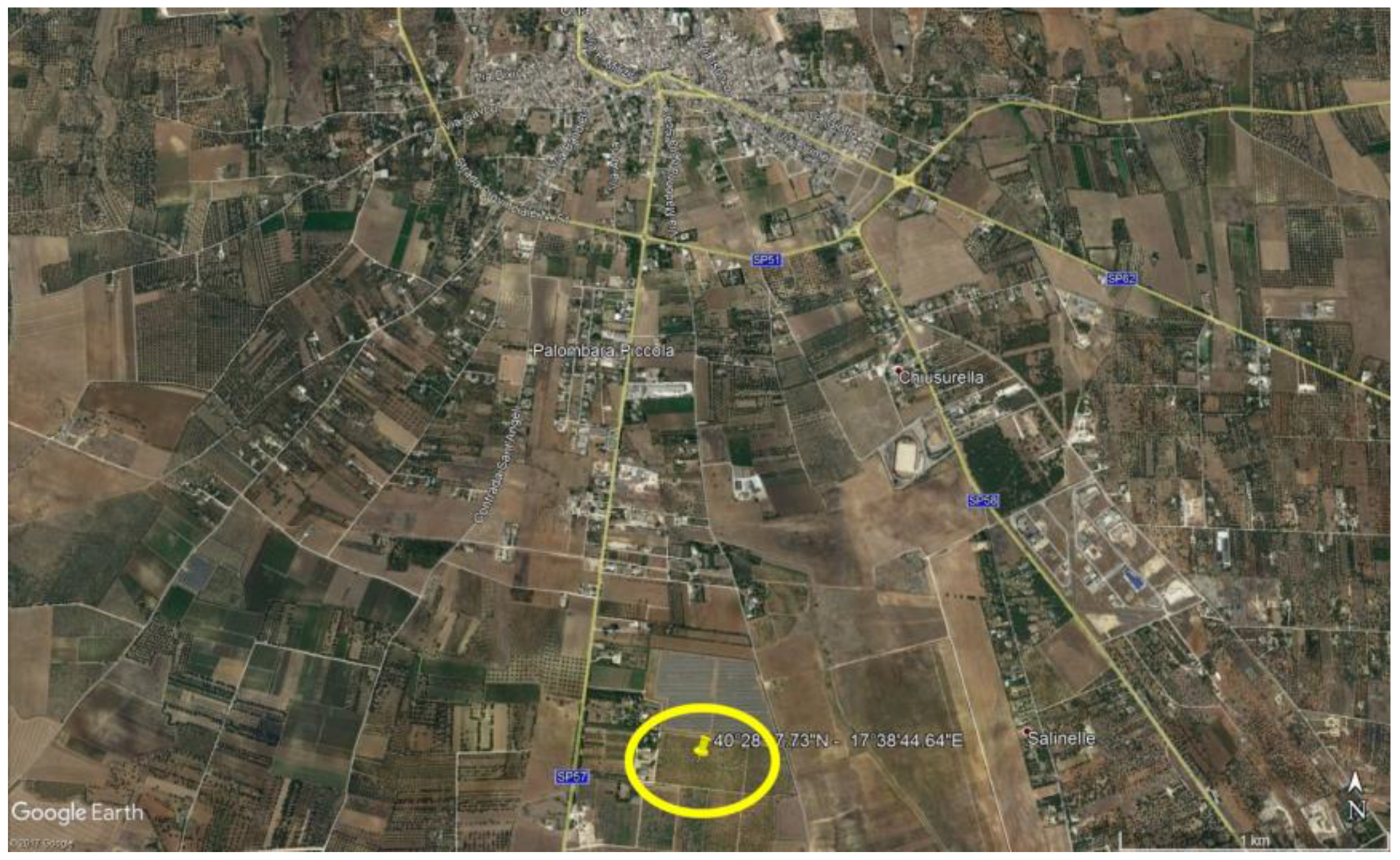

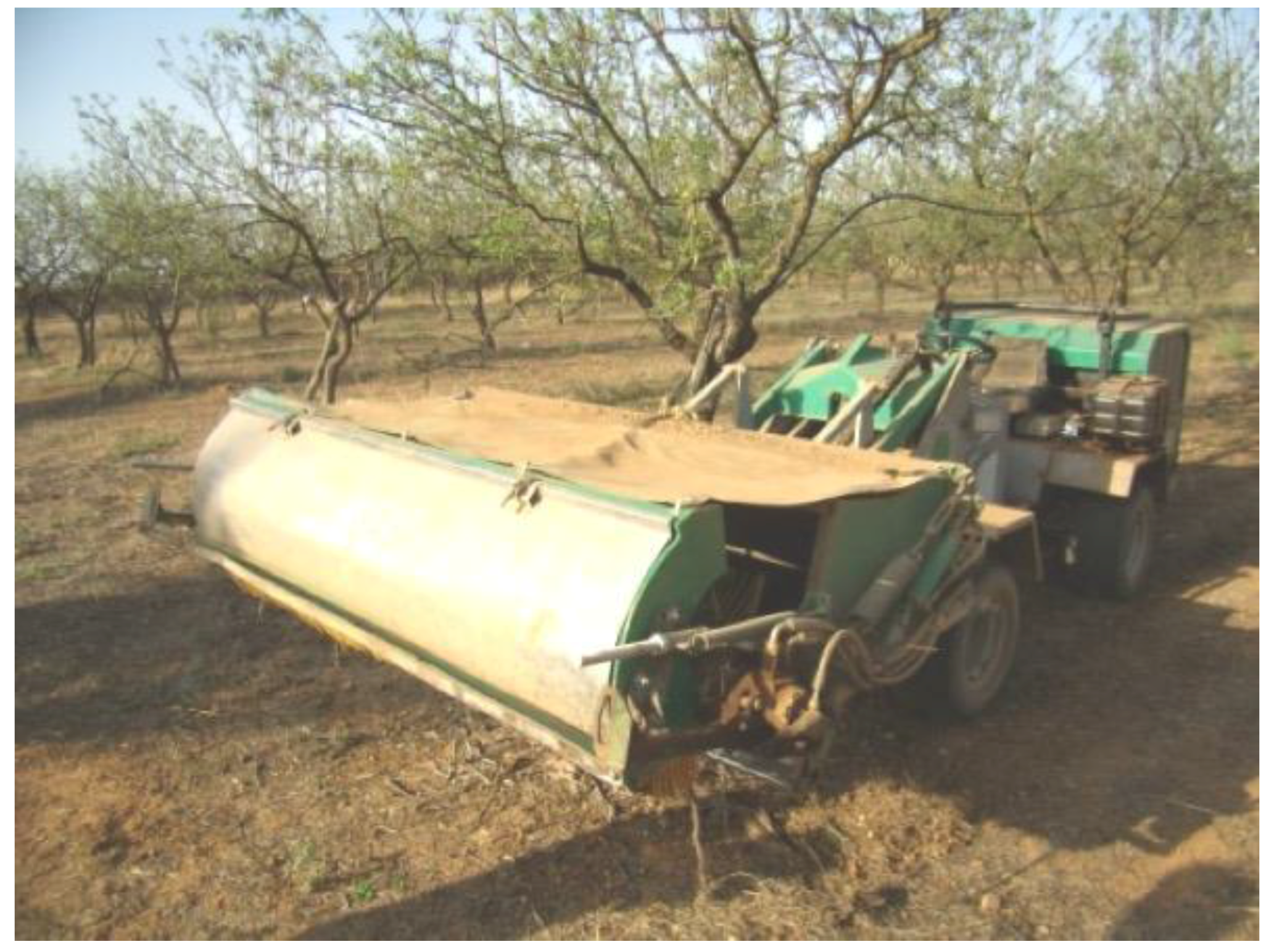
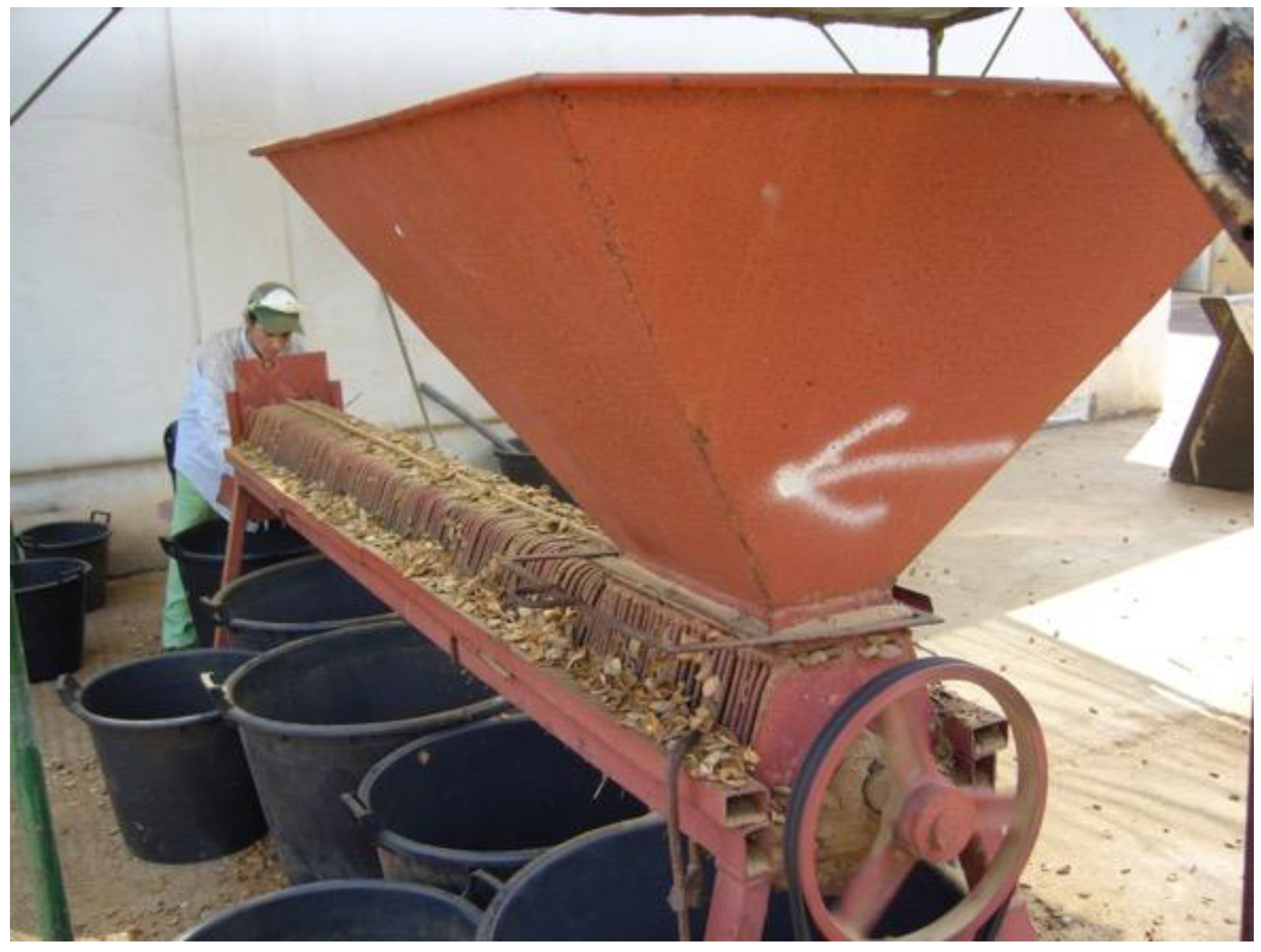
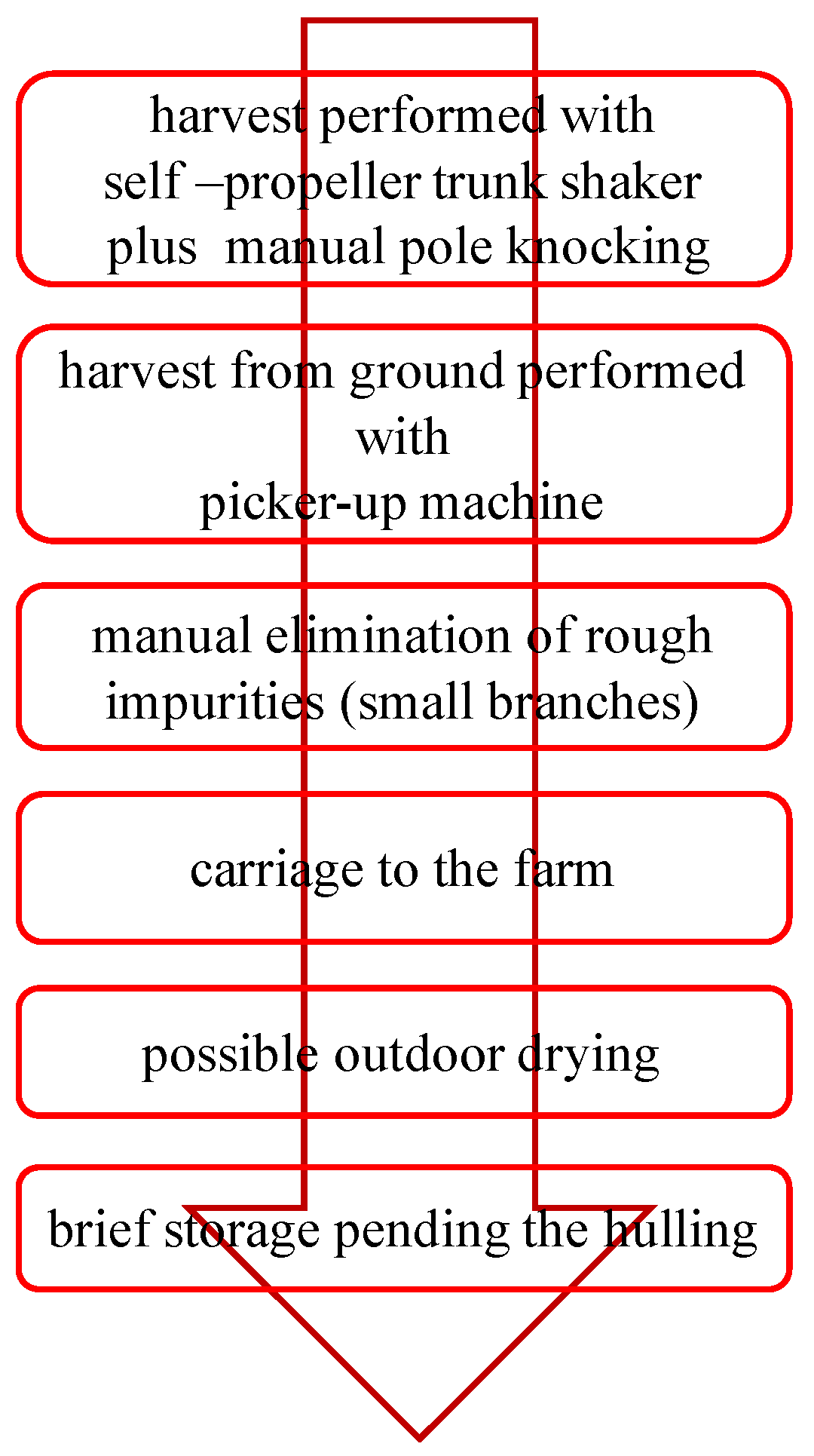
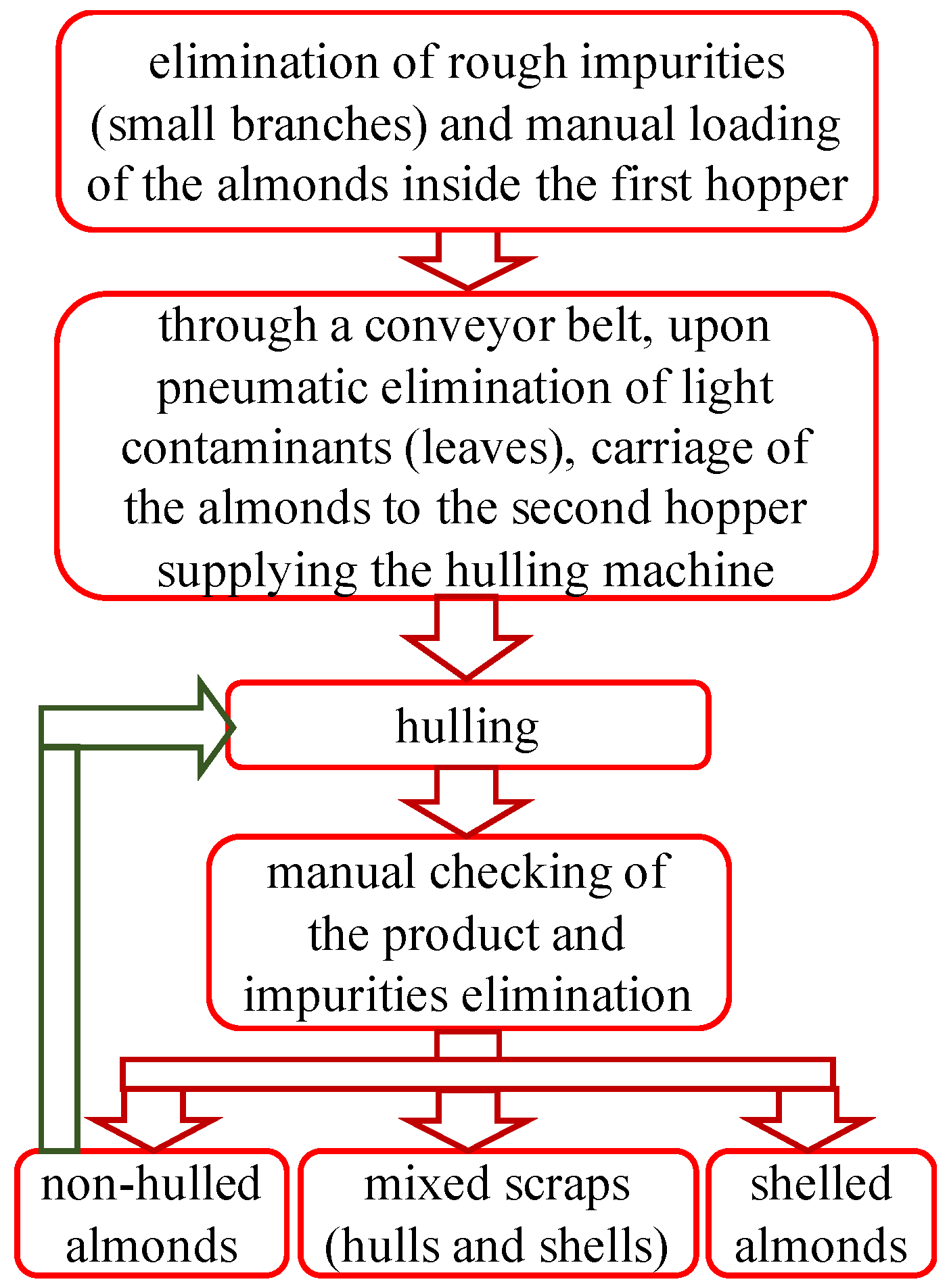
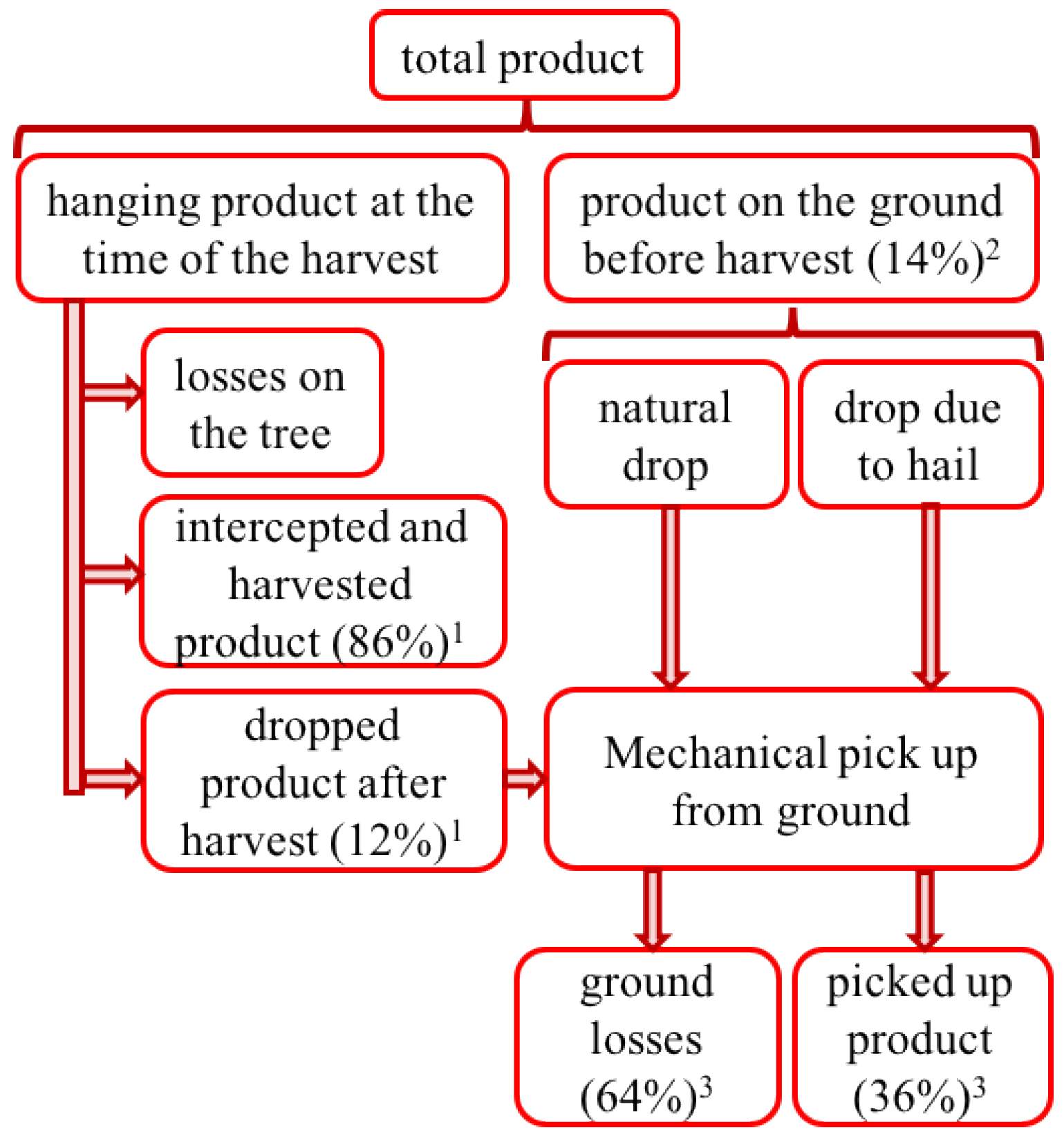

| Trees Sizes | m |
|---|---|
| Trunk circumference | 0.25–0.55 |
| First branches height above ground level | 0.60–1.00 |
| Tree height | 3.00–3.60 |
| Canopy width | 2.80–4.00 |
| Canopy height | 2.50–3.00 |
| Harvesting time | s·tree−1 | 102 |
| Harvesting capacity | h·ha−1 | 11.3 |
| Harvesting chain and labor productivity | kg·h−1 | 3.7 |
| number of trees·h−1 | 35 | |
| worker hour·ha−1 | 34 |
| Operations | Machine-Hours/100 kg | Worker-Hours/100 kg |
|---|---|---|
| Manual beating and product recovery through nets | - | 2.0–2.7 1 |
| Mechanical harvest through shaker with interceptor and manual beating | 0.27 | 0.80 |
| Mechanical ground pick-up harvesting | 0.37 | 0.75 |
| Total | 0.64 | 1.55 |
| Hulling | 0.60 | 1.2 |
© 2017 by the authors. Licensee MDPI, Basel, Switzerland. This article is an open access article distributed under the terms and conditions of the Creative Commons Attribution (CC BY) license (http://creativecommons.org/licenses/by/4.0/).
Share and Cite
Pascuzzi, S.; Santoro, F. Analysis of the Almond Harvesting and Hulling Mechanization Process: A Case Study. Agriculture 2017, 7, 100. https://doi.org/10.3390/agriculture7120100
Pascuzzi S, Santoro F. Analysis of the Almond Harvesting and Hulling Mechanization Process: A Case Study. Agriculture. 2017; 7(12):100. https://doi.org/10.3390/agriculture7120100
Chicago/Turabian StylePascuzzi, Simone, and Francesco Santoro. 2017. "Analysis of the Almond Harvesting and Hulling Mechanization Process: A Case Study" Agriculture 7, no. 12: 100. https://doi.org/10.3390/agriculture7120100






